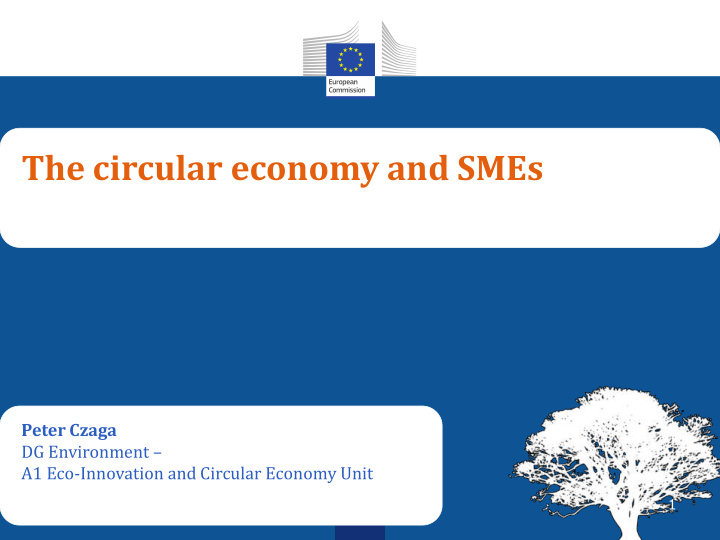



The circular economy and SMEs Peter Czaga DG Environment – A1 Eco-Innovation and Circular Economy Unit 1
Forthcoming Commission communication (01 July): "Towards a circular economy: A zero waste programme for Europe" Two pillars: 1. Setting up an enabling policy framework for a CE 2. Modernising waste policy and targets 2
The CE aims to keep the value added in products for as long as possible and to cut residual waste "close to zero". It is a regenerative system, which retains the resources within the economy in contrast to the currently prevailing 'linear' model of extraction, manufacturing, consumption and disposal. 3
What needs to be done to bring in a circular economy system? - Reducing the use of energy and materials in production and use phases (efficiency); - - Increasing the time products’ deliver their service before coming to the end of their useful life (durability); - Reducing the use of materials that are hazardous or difficult to recycle in products and production processes (substitution); - Creating markets for recycled materials (based on standards, public procurement, etc.); - Designing products that are easier to maintain, repair, upgrade, remanufacture of or recycle (eco-design); - Developing the necessary services for consumers in this regard (maintenance/repair services, etc.); - Incentivising and supporting waste reduction and high-quality separation by consumers; - Facilitating industrial clusters the clustering of activities that exchange by-products to prevent by-products them from becoming wastes (industrial symbiosis); and - Encouraging wider and better consumer choice through renting, lending or sharing services or leasing 4
Why is a circular economy interesting for SMEs? • - introducing CE solutions that deliver cost savings • - business opportunities in the transition for a CE
Forthcoming Commission communication (01 July): "Green Action Plan for SMEs" Green Greener value Greening SMEs Access to markets entrepreneurship chains Adoption target: 01 July 2014
Commission action on Capacity building: • Establishment of a European Resource Efficiency Excellence Centre • Reinforce the RE element the Enterprise Europe Network (EEN) (e.g. European Resource Efficiency Campaign, technology transfer database, etc.) • Reinforce the RE element under the workstream on clusters , e.g. under the Cluster Excellence Programme (COSME 2014-2020), alliance building on internationalisation, etc. 7
Commission action on finance: • Private Finance for Energy Efficiency instruments (PF4EE) can support SMEs undertaking small energy efficiency investments, A network and community of public and private financiers and investors that support eco-innovation will be established. • Under Horizon 2020, the societal challenge "Climate Action, Environment, Resource Efficiency and Raw Materials" is supporting the increasing resource efficiency through a systemic approach towards eco-innovation and the setting up of a circular economy. • The LIFE programme will promote the take-up of the circular business models and showcase their benefits for SMEs. • The financial instruments under COSME will specifically support SMEs to internationalise, by promoting their cross border-development. • The European Investment Bank (EIB) will provide financing through financial intermediaries for resource efficiency improvements linked to ecosystem services and climate change adaptation with the Natural Capital Financing Facility (NCFF). 8
For any further information http://ec.europa.eu/enterprise/policies/sme/index_en.htm http://ec.europa.eu/environment/circular-economy/index_en.htm 9
Recommend
More recommend